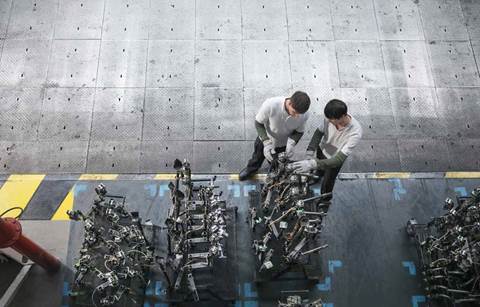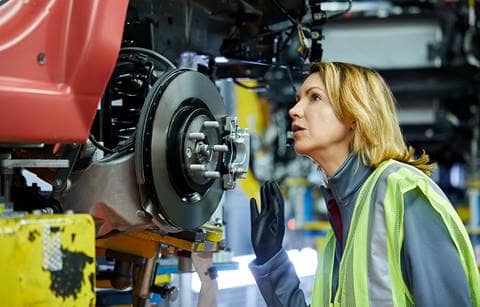Now is the time to develop and commit to your company’s transformation roadmap. Mobility megatrends and technology disruption are driving a powerful overhaul of the automotive ecosystem. Autonomous vehicles. Electrification. Ride-sharing and mobility as a service (MAAS). These trends and the technologies behind them are transforming operating models in the automotive value chain right before our eyes. Suppliers need to innovate to keep up — complacency is not an option.
Does your company have the capabilities and vision to adjust to changing market demands and roles in this new mobility era? The answer will require new definitions of your future operating model, focusing on manufacturing improvements, and identifying innovative approaches to build and acquire necessary core competencies.
Your mission as change agent and leader of strategic operational imperatives? Identify and implement strategies to build your “value- added” position in this new automotive ecosystem. It will be required for your company to survive, compete, and profit in the next generation of transportation mobility.
Analyze your current competitive position
Disruption demands a realistic assessment of your business's competitive position, core competencies, value proposition, and role in the automotive value chain. How do these stack up against the changes brought on by autonomy, electrification, ride sharing, and MAAS?
As a leader in your organization, you play a distinct role in driving strategic imperatives, offering insights into new opportunities and shaping the flexible, agile culture needed to seize them.
Determine your future operating model
New opportunities for suppliers are emerging as manufacturers shift their business models from "build-to-print" toward greater “value-added ” operating strategies. These opportunities stem from increased roles in research and development, engineering, manufacturing, distribution and services, offering tremendous potential for suppliers to move upstream in the value chain for greater contribution margin. These new roles mean providing innovation to your customers in addition to, and in many cases, in place of commoditized component items.
For most suppliers, the requirements of these business models demand a new and transformed operating model.
Plan your transformation roadmap
The operating model you choose will guide the development of your strategic transformation roadmap. What equipment and technology changes are needed? What changes to plant floor and support resources are required? What process changes to better streamline and align with customers and suppliers are necessary?
Since change doesn't happen overnight, you'll need to prioritize and sequence the steps to optimize resources for your highest return on investment.
Use the following five key drivers to help your organization develop its strategic roadmap to succeed in these times of disruptive change:
1. Shift your processes and operations to enable the new operating model.
Strengthening your design and engineering capabilities will support rapidly evolving customer needs. As changes in the automotive value chain continue to increase rapidly, customers will require a greater degree of innovation from their suppliers to design the next generation of products.
You'll need to establish realigned manufacturing and supply strategies — and process changes — to support this new role. But keep in mind, longer product development and engineering timelines will carry added risk. Today’s suppliers react — they receive plans and specifications, then they build. Tomorrow, you’ll be heavily invested in developing and implementing those plans.
Streamlining your own operations helps ensure you have the capital to invest in engineering and design resources. You already know lean manufacturing principles. The newer puzzle piece here is Industry 4.0, which connects machines, data, and people to improve productivity through "smart," seamless physical-digital integration.
Industry 4.0 will enable your shift from build-to-print to manufacturing intelligence and automation control, shortening product cycle development times. More on Industry 4.0 in a moment.
2. Forge strategic alliances to deliver exceptional products.
Streamlining operations compels you to work differently with your suppliers and service providers. What are the core competencies of your business? Understand and focus on them, then forge partnerships to fill the gaps. Outsource commodity components and services so your operations can focus on value-added activities.
This might include engaging third-party logistics providers or consolidating production facilities, as just two of countless potential approaches.
3. Put the right technical talent in place and engage your workforce to partner with customers and suppliers in new ways.
Aligning your resources more closely with your customers is an important way to reduce risk. In today's automotive ecosystem, it is primarily your sales team who interacts with customers (and focused on purchasing). In tomorrow's ecosystem, you'll need to expand your relationships to include additional critical functions, such as:
- Advanced engineering
- Product design & development
- Process engineering
- Supply chain
- Plant manufacturing & operations
- Quality
- Customer services
Your organization should have direct relationships with your customer's organization in critical, corresponding areas. This helps you gain a broader and deeper understanding of your client's business and its changing needs, which helps reduce your investment risk.
4. Increase automation and leverage IT and data analytics.
Industry 4.0 technologies both disrupt and enable. When it comes to plant floor optimization, IT and data analytics can help break down siloes within your business and streamline your manufacturing processes. For example, at a metal stamping plant, analyzing historical customer run sizes and schedules can cut the number of changeovers on the plant floor, reducing downtime and increasing capacity.
Better use of IT and data analytics in the form of connected information systems also optimizes your supply chain — streamlining purchasing, load planning and scheduling. It can create stronger connections with customers. Once you optimize your own plant floor, you can begin to align operations with your customers', creating a direct data feed of their demand, run size and other key variables. The results? Faster time to market, improvements in efficiency, and closer customer relationships.
Industry 4.0 automation technologies such as nimble robots, or collaborative robotics (co-bots), can work right alongside your staff rather than in caged areas, creating even more efficiencies.
5. Start practicing speedier decision-making.
From the C-suite to the plant floor, Industry 4.0 technologies support faster decision-making. Organizations can spend less time gathering data and more time analyzing key insights. Operations staff can gain direct access to real-time manufacturing information, enabling them to make faster, better judgment calls with less downtime and disruption. Engineering development staff can use today's sophisticated simulation tools to improve efficiency of design and engineering processes, reducing the time needed for testing and qualifying production equipment.
Begin with the end in mind
A seismic shift in mobility as we know it is taking place. To remain competitive and profitable, you'll need to evolve your manufacturing process. Start now to acquire the competencies and talent to sustain your competitive edge and position your business for new revenue opportunities in a transformed automotive value chain.
These changes aren’t science fiction — they’re here, they’re manageable, and they’re achievable. A strategic transformation roadmap will keep you focused on your vision and define the path forward, so your business can meet the demands of the future mobility ecosystem.





